Projects
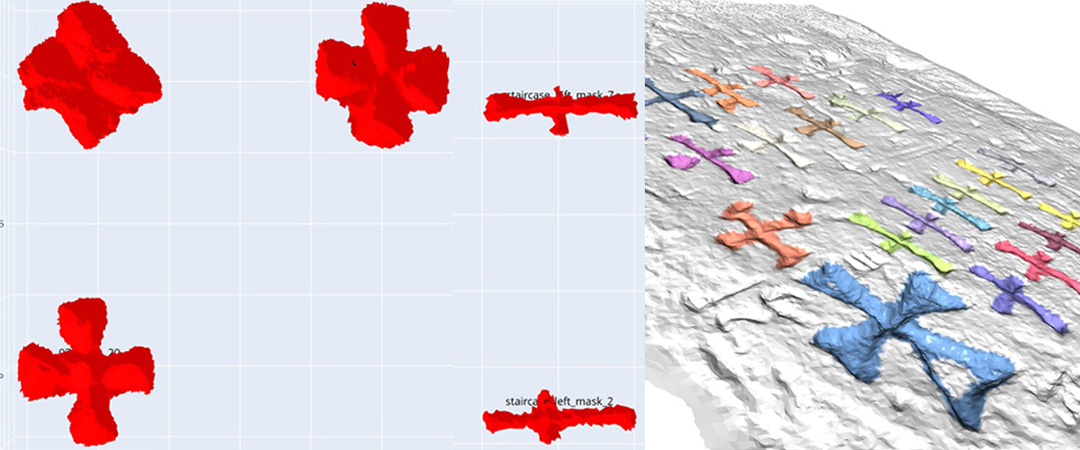
Date: 2025
Coordinators: Dr. Yoram Yekutieli, Kfir Shtokhamer (M.Sc. student): JMC
Partners: Prof. Moshe Caine, Dr. D. Altaratz: JMC. Dr. Amit Re’em: The Israel Antiquities Authority
Case Study:
Building on the foundation of the project “The Riddle of the Cross”, this study explores the application of Machine Learning (ML) to the analysis of engraved cross shapes in archaeological sites. Traditionally, such analysis relied on expert archaeologists manually categorizing crosses into distinct typologies—a time-consuming and subjective process.
In contrast, our research introduces a semi-automated pipeline for shape analysis that integrates the following stages:
- Preprocessing of 3D data
- Detection of crosses in both 2D and 3D data
- Segmentation of crosses from the stone surface background
- Feature extraction to characterize shape
- Clustering in feature space to identify shape prototypes
To facilitate data handling and interpretation, we developed two dedicated graphical user interfaces (GUIs) that support the manipulation, analysis, and presentation of results.
The preliminary results of this ongoing research demonstrate the potential of ML in archaeological research, offering scalable, objective, and reproducible methods for shape classification and typological study.

Name: Herzog Hospital Historic Photos
Date: 2025
Website: https://www.herzoghospital.org/our-history
Slideshow: The Photos
Coordinator: info@herzoghospital.org, JMC
Case Study:
The Herzog Medical Center is the oldest Hebrew Medical Center operating in the State of Israel; it is considered the first and senior-most psychiatric hospital in the Middle East, and amongst the pioneers in theory and policy of mental health in Israel. The beginning of this history is in the late 19th century. It is intertwined in the history of the “Old Yishuv” (the first settlement of the land of Israel in the modern era) in general and of Jerusalem in particular.
A short while ago, a pile of discarded glass photographic plates was discovered on the floor in an old, musty store room, some cracked or broken. They contained scenes of historic value, depicting the hospital’s activities before the First World War.
The Jerusalem Institute was happy to digitize and restore these images, thus opening up a window into another hidden corner of Jerusalem’s heritage.
* All images copyright Herzog Medical Center, Jerusalem

Name: Sole Soul, Immersive exploration of Christ Church in Jerusalem
Date: 2024
Website: https://vimeo.com/1041665940
Coordinator: Yossi Galanti, JMC
Case Study:
This 360° VR film offers an immersive exploration of Christ Church in Jerusalem, blending architecture, ritual, and introspection. The narrative unfolds as a solitary gaze moves around the church structure, experiencing its sacred spaces devoid of human presence. The journey begins in the serene garden within the church compound, wandering through the narrow ancient alleys of Jerusalem’s Old City and culminating in the church’s silent interior.
The transitions between motion and still shots mirror mental and emotional shifts, drawing the viewer deeper into a meditative state. The empty church becomes a canvas for introspection as projected montages of religious symbols fleetingly animate the walls and floor, evoking an interplay between memory, faith, and imagination.
A rich soundscape enhances this simulation of presence. The auditory journey ranges from distant, echoing church bells and jarring digital noises to harmoniously resonant music, amplifying the ethereal atmosphere. Each element works in unison to recreate the experience of encountering a sacred space in solitude, allowing the viewer to contemplate the spiritual and historical significance of the layers of this location.
Through the innovative use of VR, “Sole Soul” invites viewers to engage with the physical environment and their inner reflections, crafting an encounter between states of faith, memory, and the power of sacred spaces.
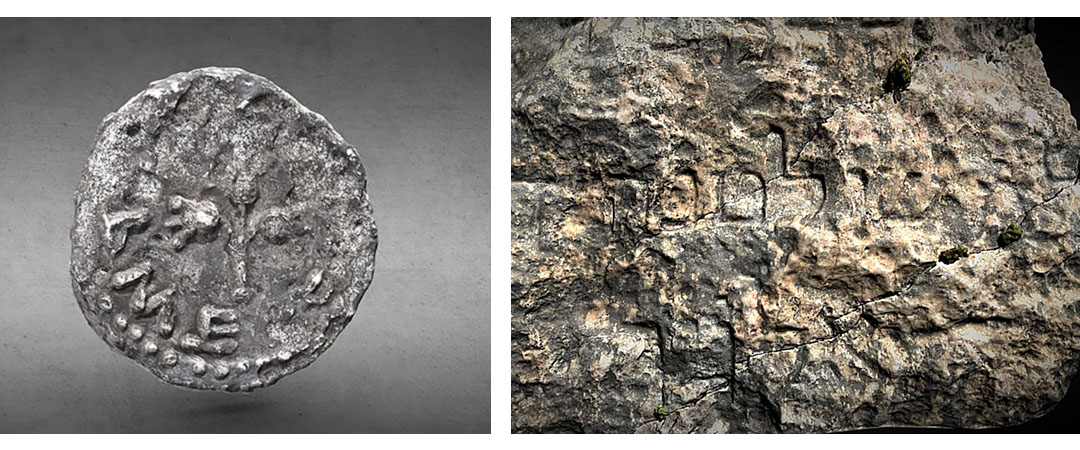
Date: 2023
Website: https://tmsifting.org/en/virtual-exhibition/
Coordinator: Yonatan Manovitz, COD Information Center
Partners: Prof. Moshe Caine, HAC
Case Study:
The Temple Mount Sifting Project is under the auspices of Bar-Ilan University and is funded by private donors through the Israel Archaeology Foundation. The sifting activity operated during the years 2005-2017 at the Emek Tzurim National Park with the cooperation and funding of the Ir-David Foundation.
The Temple Mount Sifting Project (TMSP; formerly known as the Temple Mount Salvage Operation) is an archaeological project begun in 2004 whose aim is the recovery and study of archaeological artifacts contained within debris that were removed from the Temple Mount in Jerusalem without proper archaeological care.
The project has made heavy use of crowd-sourcing, using many volunteers and tourists to help sift the debris, and is actually the most exposed public archaeological project in the world. The project sifting facility was located until 2017 in Emek Tzurim National Park. In June 2019 it moved to the Masu’ot Lookout at Mt. Scopus.
Current collaboration with the Hadassah Academic College involves the use of close-range macro 3D photogrammetry, to document, research, and display coins, bullae, weights, and other precious items.
See also: https://en.wikipedia.org/wiki/Temple_Mount_Sifting_Project
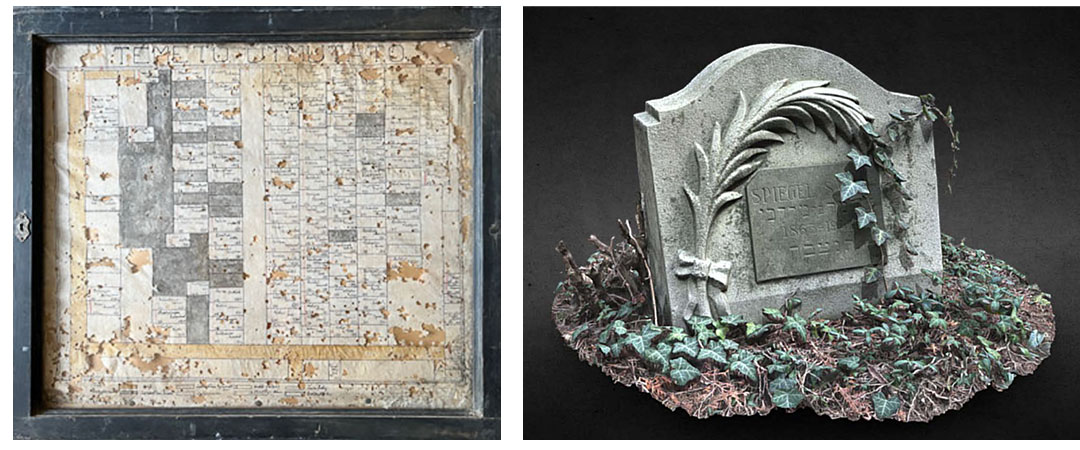
Name: If Stones Could Speak
The Jewish Cemetery of Kőszeg – Hungary
Date: 2023
Ongoing project
Website: https://sketchfab.com/moshecaine/collections/koszeg-jewish-cemetery
Coordinator: Prof. Moshe Caine, HAC
Partners: Dr. Ferenc Miszlivetz, Dr. Monika Matay, Dr. Katalin Galambos, Dr. Pok Attila
iASK Institute of Advanced Studies, Kőszeg – Hungary
Case Study:
The Jewish cemetery of Kőszeg is located in today’s Temető Street, near the Christian cemetery.
Jewish laws strictly stipulate the location of the cemetery, it must be surrounded by a stone wall and its location from the inhabited area must be at least 50 ama, so at all times outside the city outside the dwelling houses. It was no different in Kőszeg either. Today it is surrounded by houses, but when it was established in the 19th century, the town’s residential houses had not yet reached this point.
In 1854 Philip Schey Koromlay, also built a funeral home for the Jewish cemetery, which was erected in memory of his father, Moses Schey.
The current project intends to document the cemetery utilizing high-resolution photography, RTI, and photogrammetry, in an effort to preserve the rapidly deteriorating stones and inscriptions, along with the stories embedded within them.
Cemetery coordinates: 47.3843910, 16.5331850
For further details about the Jews of Koszeg: http://iajgscemetery.org/eastern-europe/hungary/koszeg

Name: The Elephant in The Room
Reconstructing a 19-million-year-old Prodeinotherium
Date: 2022
Ongoing project
Coordinator: Prof. Rivka Rabinovich, Prof. Gila Kahila Bar-Gal, Gali Bainer
Institute of Earth Science. The Hebrew University Jerusalem
Partners: Prof. Moshe Caine, HAC
Case Study:
Over the period of several years of survey and excavations, some hundreds of fossilized fragments were uncovered by a team of researchers from the Hebrew University in Jerusalem. These included a very large number of fossilized bones, making up a nearly complete skeleton of an early extinct Proboscidean, that is the predecessor of the elephant, who roamed these parts of the earth during the Early Miocene period, some 19 million years ago.
Following a meticulous and lengthy restoration process, it was decided to attempt an audacious undertaking: To rebuild the elephant and print it, in its true-life size. The method chosen: Digital replication via photogrammetry.
Currently, some 150 bones have been photogrammetrically reconstructed. This project is still ongoing.
For a complete review of the project, see:
https://www.digitalmeetsculture.net/wp-content/uploads/2021/06/EVA-2021.pdf

Name: The Riddle of The Cross
Deciphering the Engraved Crosses in the Saint Helena Chapel – Jerusalem
Date: 2017-2022
Coordinator: Dr. Amit Re’em: The Israel Antiquities Authority
Partners: Prof. Moshe Caine, Dr. D. Altaratz: HAC, Tchekhanovets: Ben-Gurion University of the Negev
Case Study:
The chapel of St. Helena in the Holy Sepulchre is an underground structure leading to a subterranean cave. Built by the Crusaders on the former remains of the great Constantine Basilica from the 4th century, it is believed to be the place where the empress Helena, mother of Constantine found the true cross. The outstanding feature of the chapel is the thousands of crosses neatly engraved into the walls of the chapel, the stairway, and behind the altars. Popular opinion states that these are graffiti of pilgrims from the Crusader period, whereas other researchers prefer to treat the phenomenon as a creation from the late Middle Ages.
This study set four main goals:
- To date the Crosses, that is, to refute or confirm the perception that they are from the time of the Crusaders.
- To see if the crosses can be categorized as graffiti.
- To decipher the identity of the cross-makers,
- To try and understand the meaning/the function of the crosses.
Dating and categorizing the crosses involved a combination of archaeological, historical, and technical collaborations. So too did the challenge of identifying the cross makers and the meaning behind their inscriptions on the chapel walls. The collaboration with the Hadassah College dealt however with the imaging aspects of the research. During the various stages of the research, different imaging techniques were employed. Photogrammetry, laser, structured light scanning, RTI, Gigapixel imaging, LIDAR, etc.
For a complete review of the project see:
https://www.researchgate.net/publication/326567575_The_Riddle_of_the_Crosses_The_Crusaders_in_the_Holy_Sepulchre
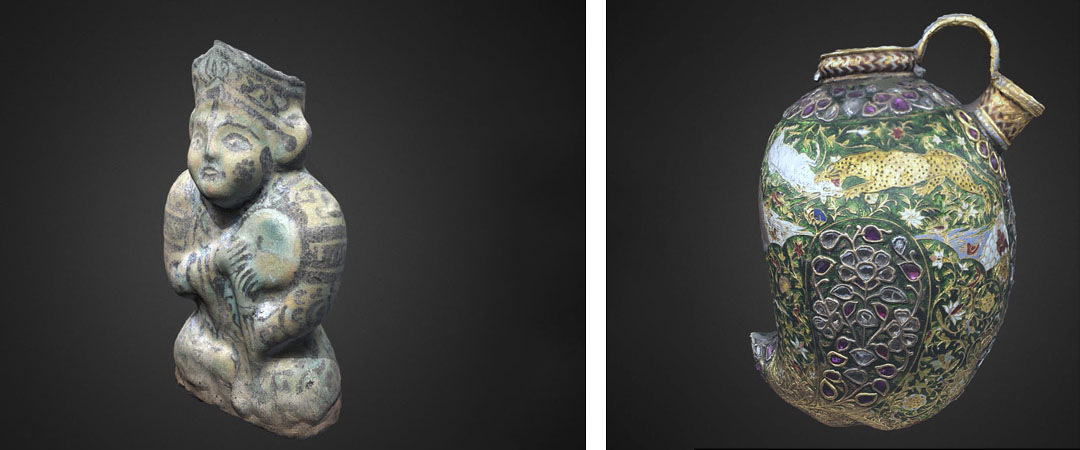
Name: The Museum for Islamic Art
Exhibit 3D Display
Date: 2021
Website: https://www.islamicart.co.il/english/template/default.aspx?PageId=105
Coordinator: Gilad Levian, Museum General Director, Prof. Moshe Caine, HAC
Case Study:
The Museum for Islamic Art in Jerusalem, the only museum of its kind in Israel, offers the public a rare glimpse of some of the world’s rarest and most special collections which tell the tale of the Islamic world, from the 7th century through to the 19th century. The collections incorporate more than 4,000 works, including gold and silver artifacts, jewelry, musical instruments, ceramics, scientific utensils, amazing calligraphy, fragile glass vessels, and copper, metal, wood, and ivory artifacts.
Following a collaboration between the museum and the Hadassah College in 2021, students from the Department of Photographic Communication under the guidance of Prof. Caine undertook a project of photogrammetric 3D documentation of some of the most important Subjects in the collection.
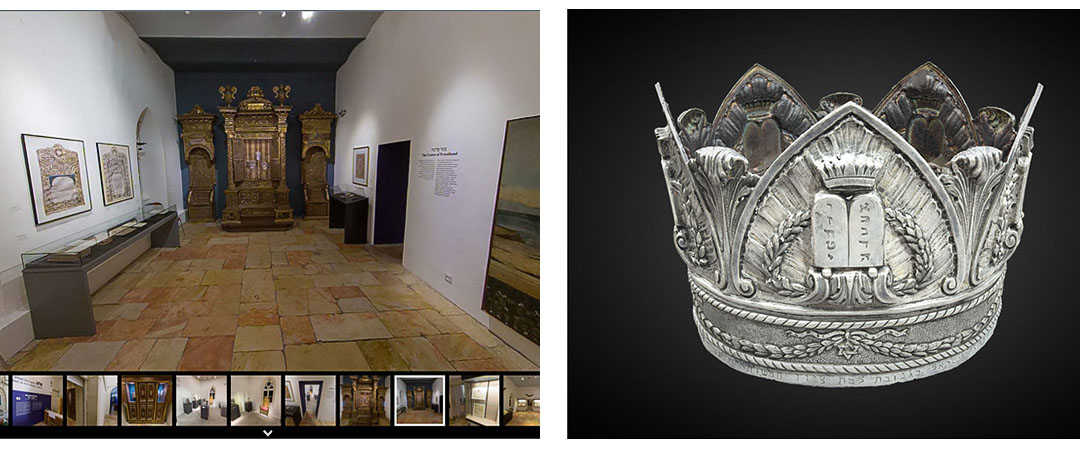
Name: The Crown
Date: 2020
Website: https://www.moija.org/copy-of-1
Coordinator: Dr. Anastazja Buttitta, Curator, Dr. Yonit Kolb, Director
Partners: Prof. Moshe Caine, HAC
Case Study:
The exhibition presents the complex relationship between Jewish culture and the idea of monarchy, through magnificent royal objects, aristocratic symbols, and ancient art treasures, as well as examines the Jewish conception of monarchy, kings, and queens. In Jewish thought, God is the Holy, Eternal, and Almighty King. The kings and queens of flesh and blood are described with their human shortcomings and weaknesses. The demand for a king is described in the Bible as an act of rebellion by the People of Israel against their God and illustrates the conflict between the human desire for a tangible ruler and the complex conception of kingship in the Jewish world.
Against this background, the symbols of the monarchy take on different and new meanings in Jewish tradition and art.
The exhibition leads visitors on a journey following the different meanings and expressions of the crown. The crown is the Torah crown used to adorn the Torah scrolls and emphasizes the importance and centrality of the Torah in Jewish life but it also has the priesthood crown the royal crown and another lesser-known crown of Shem Tov- the Good Name. The exhibition traces the various crowns and tells their story.
The Jews of Italy, who were influenced by the Italian visual culture, harnessed the values of Italian art and aesthetics in favor of the production of sacred objects of exceptional artistic quality. The exhibition will feature valuable crowns originating in Italy and will reveal to the audience rare treasures displayed in all their beauty and glory.
Mere days before the exhibition opened, the country went into the first COVID-19.
Unfortunately, for the majority of the time since the exhibition debuted, the museum remained closed. For those unable to visit the museum, or who wished to experience the exhibition from the comfort of their own home, we collaborated to offer a virtual tour of the exhibition, including 3-D scans of some of the pieces and the Conegliano-Veneto synagogue.

Name: Roman Milestones
Visualization and Interpretation
Date: 2019
Website: https://www.imj.org.il/node/4766606
Coordinator: Zvi Zuk: Israel Nature & Parks Authority,
Partners: Prof. Moshe Caine, HAC
Dudi Mevorach, Michael Maggen: Israel Museum Jerusalem
Case Study:
In 2018, a research expedition that walked the Nabataean incense route in the Negev desert in southern Israel discovered a series of hitherto unknown Roman milestones. Their exposure heralded the discovery of a new section of the road.
The historical perfume route stretched for more than 2,000 kilometers, from southern Yemen to the port of Gaza. It was used by the Nabateans to transport valuable spices and perfumes from the Arabian region to the Mediterranean Sea. With the annexation of the Nabatean Kingdom to the Roman Empire in 106 AD, sections of the Path of Perfumes were added to the Roman road system, and the army even paved new roads along it for its needs, in which this one was discovered.
The milestones were placed along the roads at regular intervals and were used to mark the distance from the nearest central city.
Initially, upon their discovery, the milestones did not show any noticeable inscriptions. However, after imaging both by photogrammetry and especially by RTI, several faint inscriptions were discerned. These inscriptions yielded the names of the Roman emperors Pertinax (r. 193–194 CE) (30x) and Septimius Severus (r. 195–198 CE). who ruled in the last decade of the 2nd century AD.
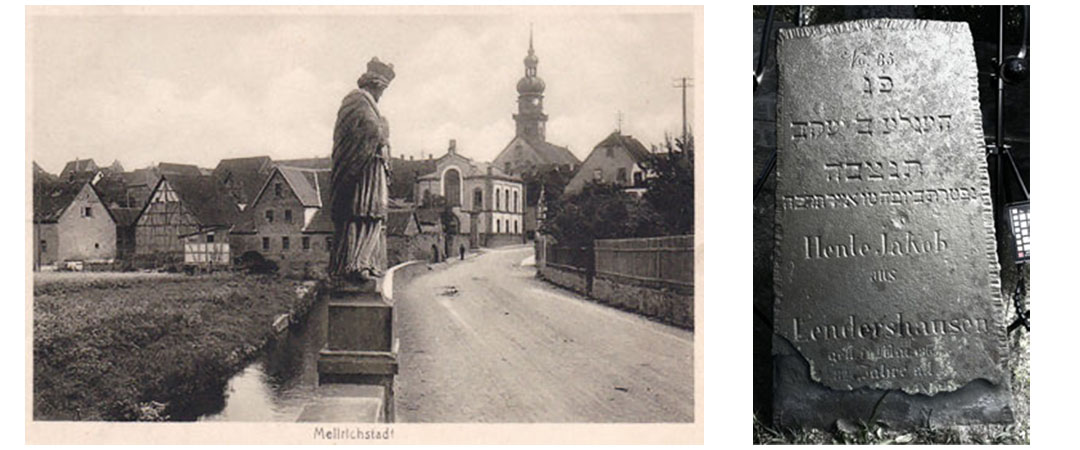
Name: Judaica Mellrichstadt
Date: 2018
Website: http://judaica-mellrichstadt.de/
Coordinator: HAC
Partners: Prof. Moshe Caine, Doron Altaratz,
Assistance: Avigail Ben Eliyahu-Leibtag, Bognan Sokol, Hocaya Toledano, Livnat Levi,
Dor Gordon; HAC
Erika Rust – Mellrichstadt
Support for the project has been generously provided by the Mellrichstadt General Town Council
Mayor: Eberhardder SStreit
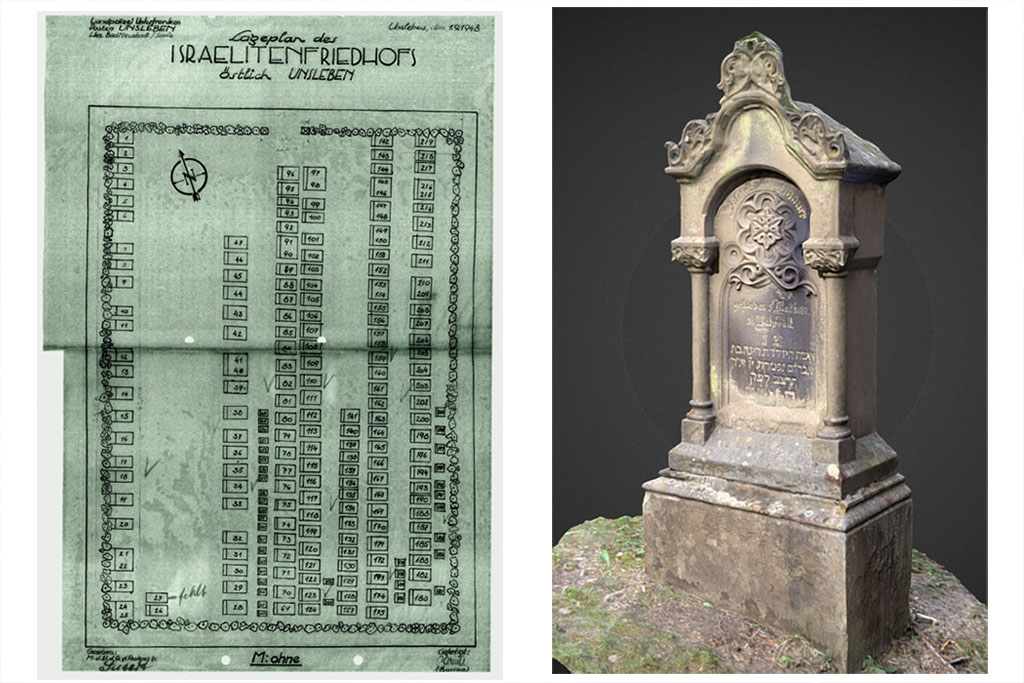
Name: Judaica Unsleben
Date: 2016-7
Website: http://judaica-unsleben.de/
Coordinator: HAC
Partners: Prof. Moshe Caine, Doron Altaratz, Eyal Tagar: HAC
Günter Henneberger: Rhön-Gymnasium Bad Neustadt
Prof. Stefan Simon: Director Institute for the Preservation of Cultural Heritage (IPCH) at Yale University
Professor Josef Hesselbach: Historian
Additional Assistance:
Avigail Ben Eliyahu-Leibtag, Bognan Sokol, Hocaya Toledano, Livnat Levi,
Dor Gordon; HAC
Lottie Nauman Hess, Arleen Hess
Angela Bungert, Matthias Poppe
Prof. Doron Zeilberger
CJH – Cleveland Jewish History
Support for the project has been generously provided by the Unsleben General Town Council
Mayor: Michael Gottwald
Case Study:
When a once vibrant community no longer exists, it leaves behind physical evidence of all aspects of communal life. The evidence is usually concrete: Public buildings, private homes, cemeteries, or artifacts. The rationale of unfolding communities is that it enables the participants to experience “hands-on” historical research of this evidence.
This site outlines an ongoing documentary project, combining historical research, cross-cultural educational work, applied visual communication technologies, and a rethinking of circles of identity. The specific documentation project discussed here focuses on a Jewish cemetery Unsleben, a small town in Northern Bavaria, Germany.
Pedagogy, history, and a delicate topic of German contemporary history are all part of a homepage that has been produced with the utmost effort and which is of great value for future generations.
Until the Third Reich, up to 250 Jewish people, families, women, men, and children alike, had been living in Unsleben for several centuries. They were respected members of society, involved in clubs, and in general, took part in village life. All village children played in the streets together, even if they visited different schools and didn’t share the same religious rituals. The adults worked hand in hand. A variety of Jewish shops, the products of which are still known to the citizens of Unsleben today, let the little village grow into a thriving hub of commerce for the regional economy. Cultural diversity, tolerance, and acceptance of different religions have let Unsleben develop into an open-minded community, which can still be perceived today.
The Nazi regime drove a wedge between the Jewish people and the other citizens of Germany, thus destroying the international community. The last Jews from Unsleben were deported to Izbica in the east of Poland, where they were killed in the different concentration camps of the area.
“Judaica-unsleben” is a cooperation between the University of Yale/USA, the Hadassah Academic College in Jerusalem, and the Rhön-Gymnasium Bad Neustadt under the guidance of highly qualified experts, who together have created a project, which contributes to the reconciliation and understanding between the nations, today and in the future.
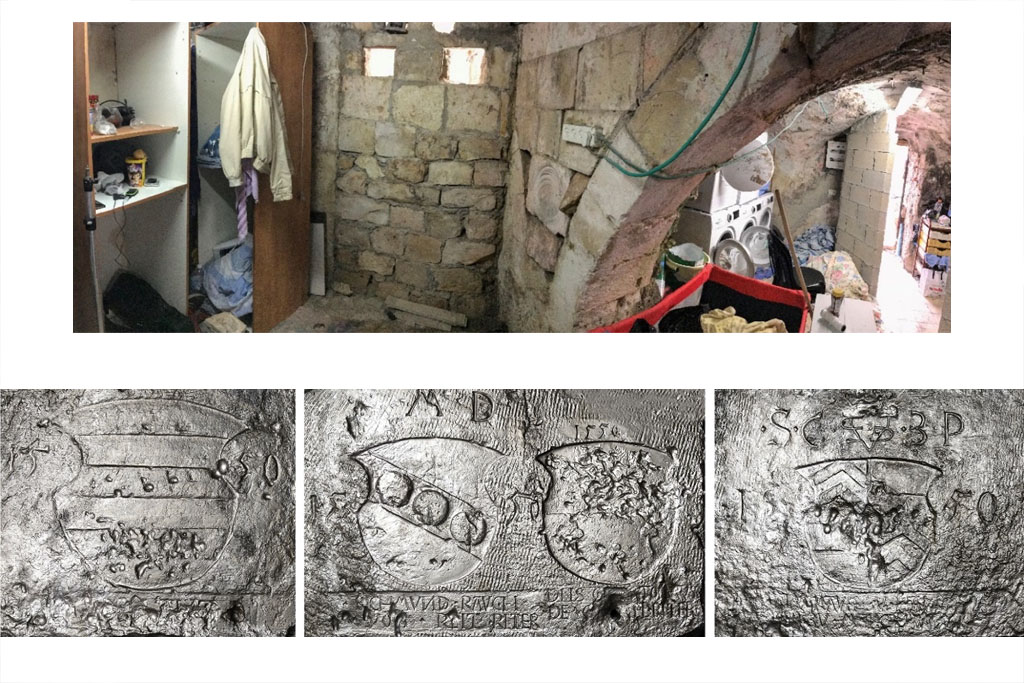
Name: The Knights Behind the Washing Machine
Mount Zion
Date: 2017
Coordinator: Dr Amit Re’em, IAA
Partners: Prof. Moshe Caine, Doron Altaratz, HAC
Case Study:
Sometimes, messages from the past turn up in the most unexpected places. One such case was again on Mount Zion, but this time in a Jewish Bible learning institution, open to young men, students from all over the world who live in the ancient rooms that are scattered on the first floors of the compound. One such small room serves as the communal laundry with a washing machine and shelves. Several years ago, during the cleaning of the room, unidentified inscriptions were discovered behind the washing machine. RTI of the inscriptions identified them as being the heraldic shields of German knights of the 16th century. The date 1650 appears clearly, as too the Coat of arms belonging to the district of Meissen in Germany.
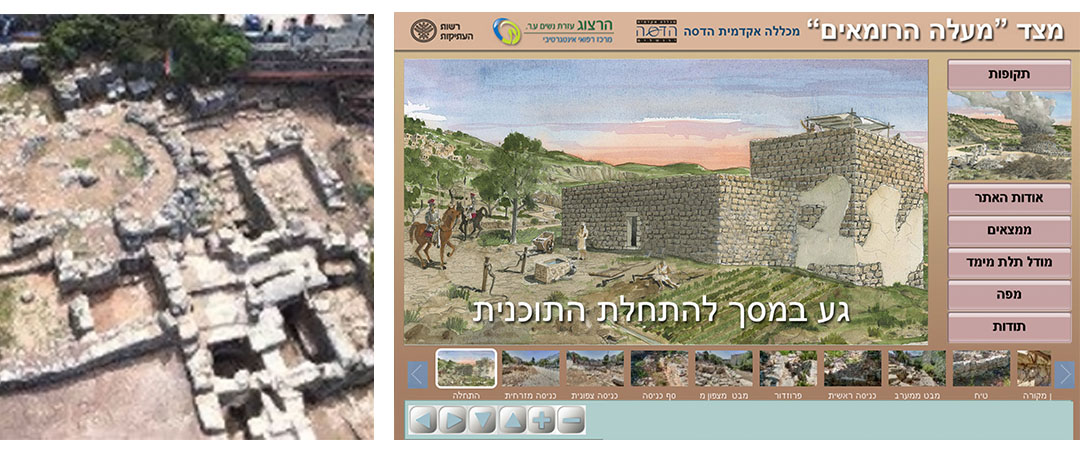
Name: Ma’ale Roman Fortress
Herzog Hospital – IAA
Date: 2014
Coordinator: Herzog Hospital Jerusalem, Yuval Baruch – IAA, Moshe Caine – HAC.
Case Study:
Ruins of a fortification from the Roman period are located on the grounds of the Herzog Medical Center, in Givat Shaul at the entrance to Jerusalem, Archaeological reconstruction work revealed that this is an outpost, which was used as a fortress in the Hasmonean period. Around it were terraced with agricultural crops, and it was built, apparently, to protect the farmers and their livestock from looting. Excavations at the site began as early as 1967 and were directed by the late Greek archaeologist, Prof. Vesalios Tsapiras.
According to Prof. Tspires, the post was inhabited, apparently, continuously for 600 years, From the Hasmonean period to the Byzantine period. The Roman government that took over the lands of Israel used the outpost to protect the road going up to Jerusalem, from its western entrances, and added a second floor, to improve the observation and protection of the area from the outpost. The staircase, built by the Romans, to connect the first floor to the second in the outpost has been kept in good condition and has been restored.
During the Byzantine period, the outpost was abandoned for many hundreds of years, until the Mamluk period (which began in 1260 AD). During this time, the outpost was apparently used as a lime production site.
The archeological reconstruction revealed a circular structure inside the site, where, according to the hypotheses, the lime pit (a kind of kiln) is located. During the excavations, many pottery vessels from different periods were discovered in the area, which shed light on the ongoing history. Among other things, pottery bottles for oils and perfume from the Hasmonean period, pottery candles for lighting and deep bowls, in a red shade, from the end of the Second Temple period, and other cooking utensils from various periods were found. The many finds were transferred to the warehouses of the Antiquities Authority.
Currently, plans are underway to establish an archaeological garden on the spot which will allow the general public to visit this important historical site. To this purpose, collaboration with the Hadassah College included a photogrammetric survey and modeling of the fortification and the creation of an interactive tour of the site.
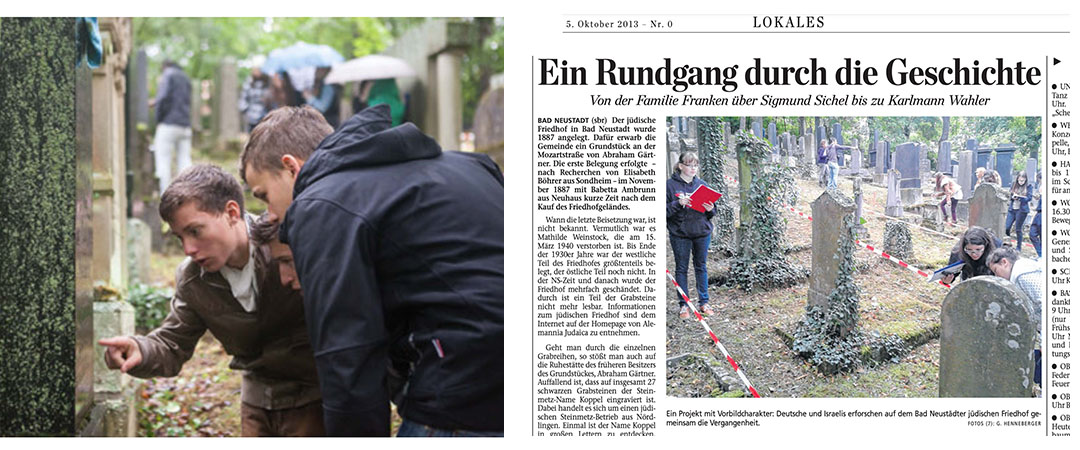
Name: Unfolding Communities – The Lost Jews of Bad Neustadt
Date: 2014
Website: http://www.judaica-badneustadt.de/bn/
Coordinator: HAC
Partners: Prof. Moshe Caine, Eyal Tagar: HAC
Idit Ben Or: the Hebrew University in Jerusalem
Günter Henneberger: Rhön-Gymnasium Bad Neustadt
Prof. Stefan Simon: Director Institute for the Preservation of Cultural Heritage (IPCH) at Yale University
Raanan Kislev: Head of the Antiquities Authority’s Conservation Admin.
Sigrid Brunner: Journalist, Bad Neustadt
Additional Assistance:
Rabbi Jana De Benedetti – B’nai Zion Congregation. Shreveport, LA
Helen Lefkowitz Horowitz – Parsons Professor of History emerita, Smith College
Dr. Rotraud Ries – Johanna-Stahl-Zentrum
Prof. Ernst Benz – Smith College
Hodaya Toledano – Hadassah Academic College Jerusalem
Support for the project has been generously provided by the Bad Neustadt General Town Council
Mayor: Bruno Altrichter
Chief Administrator: Mr. Michael Weiß
Case Study:
In September 2013, a joint high school exchange program of German and Israeli students between the high schools Mikve Yisrael High School (Holon, Israel) and the Bad Neustadt Rhön Gymnasium (Bad Neustadt a.S., Germany) set out to restore, renovate and document the abandoned Jewish cemetery of Bad Neustadt an der Saale, where all traces of a once thriving Jewish community vanished following the annihilation of the Jews during World War 2.
The student’s documentation of the cemetery brought to the table new information. The documentation cards gave us an idea of how many men, women, and Children were buried. In some cases, we can learn the causes of death. Some leaders of the community have become evident: Teachers, doctors, people who were known to give charity, etc.
From the places of birth stated on the grave, we learned where people emigrated from.
By reading what people chose to engrave, we can learn what they wanted to emphasize. A very interesting example is a few graves of men that mention the unit they fought in during World War One. This teaches us about identity in regard to national affiliation.
This information needs to be treated carefully, just like any text. Questions need to be asked on motives and social structures. However with a careful analysis that cross-references the documentation material with archives and local knowledge, much can be learned.
This cemetery is one of many in Bavaria that is not documented and many of the graves are already unreadable. The main initial goal of the project was to clean up and map out the cemetery and to document each grave. Already at this stage, the joint work of students proved to be a pathway to asking questions about personal and communal identity, beliefs, preconceptions, and joint values. Furthermore, the information gathered was used to expand the knowledge about the Jewish community of Bad Neustadt. History books did not pay much attention to this small peripheral community. The tombstones were able to shed light on aspects the students would not be able to learn about through other written sources.
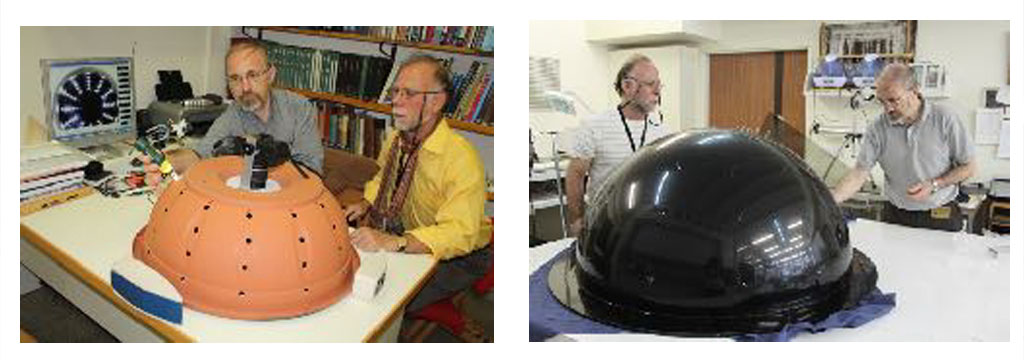
Name: Building the Israel Museum RTI Dome
The Israel Museum
Date: 2012
Coordinator: Michael Maggen – Israel Museum, Moshe Caine – HAC.
Case Study:
In 2011, initial tests in the use of Reflectance Transformation Imaging (RTI) were introduced into the workflow of the Israel Museum by the Hadassah Academic College. These were rapidly taken up by the Paper and parchment conservation laboratory, headed by Michael Maggen.
RTI is a technique for discerning and enhancing surface textures on various objects, both outdoors and in the studio.
While outdoor RTI is usually performed by a technique known as the Highlight method
(http://www.c-h-i.org/learn/media/RTI_Hlt_Capture_Guide.pdf), studio imaging of repetitive small objects such as coins, ostracon or potsherds can benefit from a streamlined semiautomated method known as Dome RTI. This involves the use of a hemispheric dome into which are embedded 48-72 LED light sources which a controlled sequentially by computer and tethered to a camera. This process is fast, accurate and repeatable.
Unfortunately, at the time such domes were not commercially available and had to be constructed on an individual basis.
At the first stage, a prototype dome was made and tested successfully. Following that a more sophisticated automated dome was constructed in the museum and is in use ever since.

Name: The Genesis Apocryphon. Infrared & RTI
The Israel Museum / IAA
Date: 2011
Coordinator: Pnina Shor – IAA.
Participants: Dr. Greg Bearman – Caltech JPL (retired), Dr. Adolfo Reutman – Israel
Museum, Moshe Caine – HAC
Case Study:
Early tests in the application of combined infrared and Reflectance Transformation imaging to fragments of the Genesis Apocryphon, also called the Tales of the Patriarchs or the Apocalypse of Lamech and labeled 1QapGe. It is one of the original seven Dead Sea Scrolls discovered in 1946 by Bedouin shepherds in Cave 1 near Qumran, a small settlement in the northwest corner of the Dead Sea. Composed in Aramaic, it consists of four sheets of leather. Furthermore, it is the least well-preserved document of the original seven with the texts virtually unreadable under the thick layer of encrustation.
The work carried out at the IAA laboratory aimed at testing the viability of using non-conventional photographic technologies to assist in the fragment’s analysis. Infrared imaging aided the non-invasive penetration of the encrusted surface, while the RTI aided in assessing the hidden surface texture.
